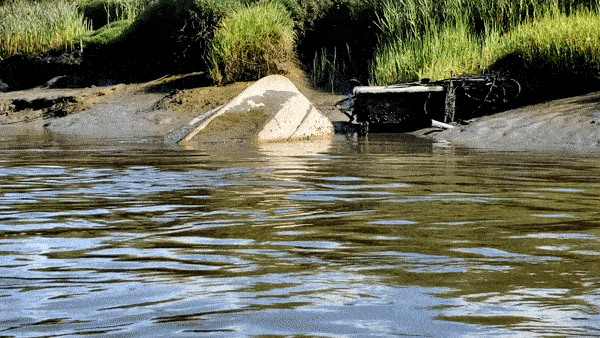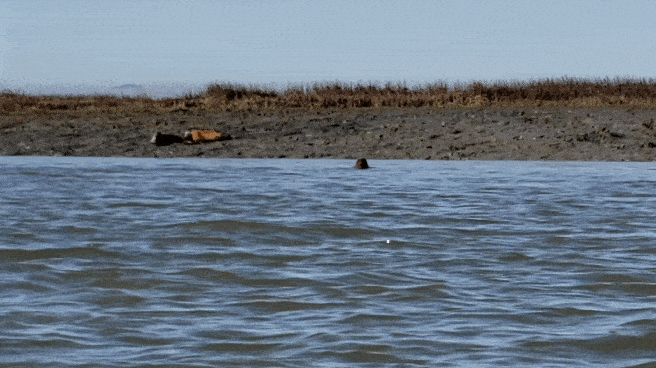Being in nature is always exciting, but it can turn into downright terrifying if you have no clue how to deal with changing conditions. I found out the hard way in a kayaking trip I made in February.
Below is the story about that trip.
----
----
I am not planning on spending more than 4 hours kayaking, so I decide to go where Alviso slough meets Coyote Creek, which should take 2 hours one way, plan to have my lunch over there and return back in another couple of hours.
Find below the route I had initially planned.
The Don Edwards national wildlife refuge which is what all the green areas on the map in the first image are part of, allows hunters to hunt waterfowl during November through January. Having shared the same waterways with these people riding their motorboats in the past, it's better to keep a safe distance since they don't slow down in the presence of kayaks because a minute lost is equivalent to one duck lost, and that swell of waves can make the kayakers having to pull all their strings to stabilize their kayaks. So as a precaution, I always keep my distance from them and stick closer to the land whenever possible in the fear that one of these will race from behind.
I stick to the right side, since I see a fishing boat in the middle of the bay. Suddenly, I see big boulders moving on the land through the corner of my eye. Turns out I scared a group of harbor seals who were resting on the land and they start jumping in the water to avoid the predator(read me). I see them popping their heads 30 feet from my kayak trying to get a glimpse of someone who wandered too close. Below are the Harbor seals after several jumped in the water.
I stick to the right side, since I see a fishing boat in the middle of the bay. Suddenly, I see big boulders moving on the land through the corner of my eye. Turns out I scared a group of harbor seals who were resting on the land and they start jumping in the water to avoid the predator(read me). I see them popping their heads 30 feet from my kayak trying to get a glimpse of someone who wandered too close. Below are the Harbor seals after several jumped in the water.
Takes me another 90 mins before I get close(0.5 miles away) to Palo Alto Baylands Sailing station, but sensing the water was not deep enough and my paddle stirring up mud, I knew it would be risky to venture further but I can still move and am not stuck. At this point, it might be 12 pm, and the low tide is at 3:30 pm. So even though I was feeling hungry, bear in mind I just had oatmeal in the morning(and paddled almost 9+ miles on my kayak, also biked about 9 miles while carrying my kayak) I decided to head back into deeper waters before I can stop and have my lunch. So I start paddling towards the East bay.
This is the path I took shown in the animation below:
I start to wonder if I can drag my kayak towards the east bay, where I can reach the deep channel and head home unscathed albeit a bit mucky.
I get off my kayak and my feet immediately sink till my knees in the ground, but the sinking slows down after that, so I start dragging my kayak, and it takes more effort to move around because each step is sinking. Then there are a few spots where there is a little water, sensing a lot of effort to get around it, I walk through it. Turns out it was a much deeper hole and it sucks me till my chest, but since I have the floatation device and held on to the kayak, I can stop completely sinking in and climb back up in my kayak.
Now I am super exhausted and super mucky, so I jump back into the kayak. When I board the kayak back, I bring all the muck with me. Trying to catch my breath back, I think eating a sandwich will give me a boost of energy so I can think clearly on my next steps. Turns out the muck has engulfed the sandwich, when I open the aluminum foil. Getting super frustrated at this but also utterly helpless, I try to see if there is any part of the sandwich that is not covered in muck. Keep in mind this is not a fancy sandwich, just 2 slices of multigrain bread and a hash brown in between. I am able to consume about a quarter of the sandwich before I start tasting the mud in my mouth. I have about 16 oz of water left at this part.
The struggle continues and I get back off my kayak, sometimes keeping one foot inside the kayak and pushing with another to get around those deep spots. After almost a mile of walking south, I can walk no more. Watching the waders just moving further away towards the east bay by every passing minute is disheartening(meaning more and more areas are now receding). And so I decide to tell someone in case I don't make it back in time. I get back on my kayak, and take out my cell phone, but since my hands are filled with mud, I can't use the fingerprint sensor. Even the pattern unlock is hitting all the wrong points, so my phone locks after consecutive wrong attempts(for a min). I wipe the muck on the part of the clothing that is still clean and try again. Phone unlocked! I call my friend but it goes to his voicemail, so I leave a message. In addition, I also make a call to Alviso marina county park, but no one is picking up. I call Don Edwards Wildlife Refuge and am greeted by an automated message talking about the history about the refuge. Now, not only I am devoid of any energy but also without any viable options. So I wait in my kayak, that's when the afternoon winds pick up.
You see the bay has winds that pick up around 11 am, with them intensifying around 1 pm and slowing down as evening approaches. I get a call from my friend and it turns out he did not listen to the voicemail. So I explain my situation and ask him to drive to Alviso marina county park and check with the rangers if there is something I should be doing. And now soaking wet and shivering from the winds, I play the waiting game. I put my phone into power saving mode because I have about 50% of the battery left and I don't know what's ahead. I get a call back from my friend in 15 mins who was able to contact the ranger and says that I should expect a call from the ranger any time now. As I put that call down, I get the call from the ranger who asks me to give my gps coordinates.
This is where I was stuck, the time is around 1:55pm.
At this point, I just want to close my eyes and fall asleep because there is not much I can do, except shiver from the cold. I set an alarm 2 mins before the call, so I don't end up missing the call. It works, he calls me every 30 mins and I tell him the status and in each call he asks a little bit more about me, like my age, how much water I have left, how fatigued do I feel, the color of my kayak and the clothing I am wearing. If you look at the gps coordinates I showed, it looks like just a mile to reach land in Mountain View, but the ranger has warned me no matter how tempting it is to walk on mud, bad things happen when the water starts coming back and covering deep holes and is a quicksand just waiting to swallow me up, so I stay put.
This is what it looked like when I was playing the waiting game.
And off we go, paddling a few feet, I feel the kayak to be really unstable and it takes a lot of effort to stabilize it against the strong waves. Turns out the muck had now separated the mud which settled at the base of the kayak and the water which was floating and just sloshing around tilting my kayak side by side with every paddle. I make good progress but the tides are getting stronger as well, and I start losing daylight really fast.
At about 6:30pm, it gets dark and the ambient light is making it really hard to see how far is the land. Even though I do use Google maps to see if I am paddling in the right direction, I don't seem to be making any progress. The waves are so strong, that the moment I take my hands off the paddle to answer the call or check google maps, it changes my the orientation of kayak and pushes me towards the shore. So I put my right hand outside my kayak and touch the mud AGAIN! Below is where I got stuck, so close yet so far.
Finally after those intense 30 mins, I reach the trail and get on land but am having trouble pulling the kayak on the land because of the weight. Falling on my knees and pulling with all my body weight, I manage to bring it on land. Draining several gallons of waters, I start walking towards the trail, carrying my kayak with me. I let the US Coast guard know to forgo contacting the Fire department, since I can walk back. It is almost 4 miles back to the Alviso marina county park and even though I thought I had enough energy to get back, I catch myself occasionally closing my eyes while walking to conserve energy.
This is the spot where I crashed my kayak and got on to the trail for the walk ahead. (photo not taken on the same day)
After 90 minutes, I reach the gate, let the US coast guard to leave me alone and call my friend to pick me up and ask him to bring water and food.
In short, a 4 hour kayaking adventure turned into a 13 hour ordeal with a story to tell.
After that day, water has never tasted sweeter, food tastier and traveling by bike faster.
A few blisters on my fingers, a sore back and shoulder muscles but taking a sick day let me recover fast.










No comments:
Post a Comment
Did you learn something new in this post? Let us know in the comments below